Many of our dietary decisions have been based on a very flawed and obsolete graphic known as the food pyramid. Scientists have ingrained this visual data into our everyday lives and have been doing so since the early ‘90s. In fact, it is probably the only thing you may remember from health class in elementary school. But how did the science go so wrong and has anything been done to correct these archaic guidelines? Has someone been able to create a more healthy and sustainable way of eating? Fortunately, the answer is yes. Everything we thought we knew about the foods we eat has literally been flipped around to create a healthier and more sustainable way of eating. Enter the keto diet pyramid…
A Closer Look At The Traditional Food Pyramid
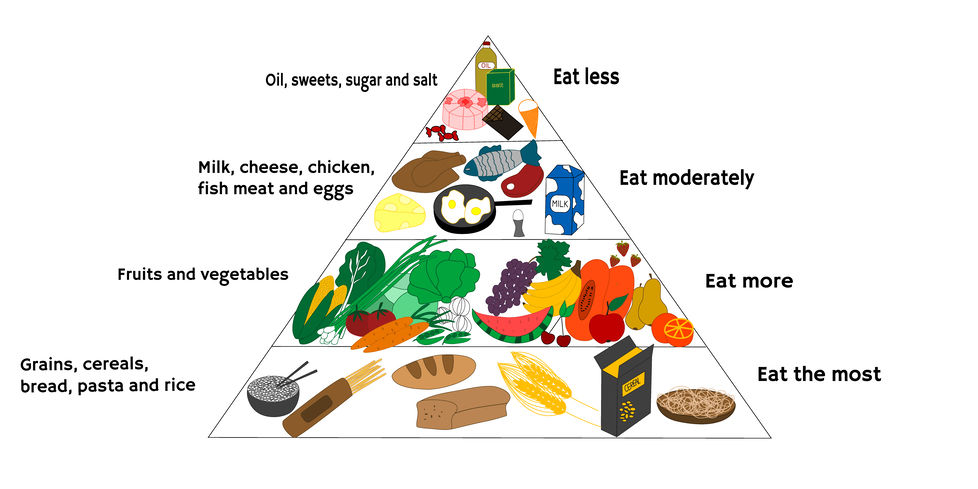
In order to address the obesity epidemic and encourage the nation to make healthier choices about food and nutrition, the USDA (United States Department Of Agriculture) introduced the official food pyramid in 1992 to serve as a dietary guideline that was easy to follow for every American. The triangular diagram was designed with six horizontal blocks, each representing the different food groups and daily serving amounts.
The base layer, which is the largest of the blocks represented grains and carbohydrates such as bread, rice, and cereals with a suggested 6 to 11 servings.
The second tier above the base was divided into two sections to represent the fruit and vegetable groups. The recommended daily serving of vegetables being 3 to 5 and 2 to 4 for fruit.
The third tier was then divided into the dairy and protein food groups, both with a recommended daily serving of 2 to 3.
The tip of the pyramid, which is the smallest of the blocks, represented fats and sugars. There was no recommended daily serving but it was noted that this food group should be used sparingly.
MyPyramid
In 2005, the traditional food pyramid was revised with colorful vertical wedges to replace the traditional horizontal blocks and was renamed to MyPyramid. The revised pyramid consisted of 5 wedges to represent grains and carbs, fruits, vegetables, dairy, and protein with the focus weighing heavily on carbs, fruits, and vegetables. Fats were still only given a tiny sliver, meaning that it was still advised to eat this food group in moderation.
The new and improved pyramid also included serving sizes based on age and activity levels, which at the time was believed to help with personalization according to each individual’s needs.
MyPlate
The MyPyramid was revised yet again in 2011 and instead of the traditional triangular diagram, it was changed to represent a place setting consisting of a plate and a glass on the side.
This nutrition program was aptly renamed to MyPlate. The plate diagram was divided into 4 similar sized portions to represent fruits, vegetables, grains, and proteins. Dairy is added in a separate circle to the side of the plate, which represents the glass in the place setting. This version of the food pyramid is still in use today and serves as the official food and nutrition guidelines.
While the food pyramid has gone through a few revisions, it still has its flaws, which could be the major factor behind the obesity, nutrient deficiencies, and cardiovascular epidemics we are facing today.
Flaws In The Traditional Food Pyramid Programs
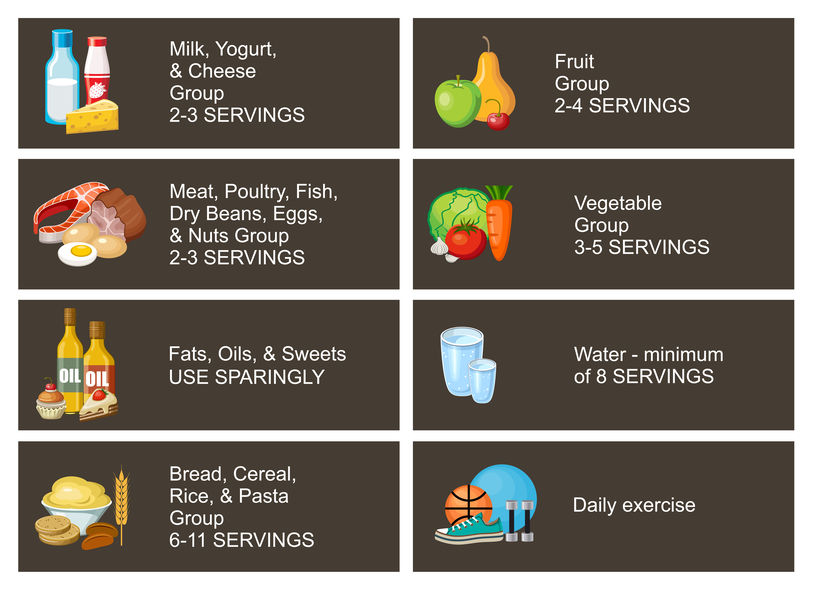
The major flaws present in all three versions of the food pyramid programs is that the focus of American diets is shifted towards eating low-fat items with larger portions of carbohydrates and grains. These are the two flaws that the keto food pyramid has addressed, which we will get to shortly.
There is no dispute that whole grains in moderation can benefit our health in a few ways, but unfortunately, these programs do not really specify that not all grains and carbs are created equal. The recommendations for which kinds of breads, pastas, and cereals are vague by only suggesting that half your grains should comprise of whole grains, leading most people to believe that refined choices like white bread and pretzels are perfectly fine to incorporate into daily meals.
With a combined annual grain revenue of roughly $60 billion, it makes sense to drive consumers to purchase grain products. It is also a fairly affordable way to keep consumers fueled with the energy our bodies need in order to function, but the problem is that carbohydrate-dense foods like grains, especially when they have been refined or processed could be doing more harm than good. According to various studies, processed grains, which usually contain high amounts of table sugar like ready to eat cereals, yeast breads, and grain-based desserts increase our chances of heart disease by up to 38%. The very real and frightening fact is that the majority of pre-packed grains we find on the shelves today have been processed or refined. Even if a label on a cereal box mentions whole grains, these grains have still been pulverized into a very fine powder, which ultimately has the same metabolic effects as refined variations.
The second major flaw of the traditional food pyramid programs is that all types of fat have been placed in the same groups with the common notion being that all fats are unhealthy. The dietary guidelines specify opting for low-fat products instead of making wise choices about healthy fats such as ghee, full cream, and other sources of healthy oils.
For years, fats have been a swear word in the dietary dictionary and we have been urged time and time again to avoid them altogether. But this is where they got it wrong. In 1977, when the low-fat dietary guidelines were released to the public, there were no studies done at the time to back up any claims that a low-fat diet was, in fact, a healthier option. As a result of this uncontrolled “experiment,” both obesity and diabetes epidemics began to rise, and today, many people are still suffering the consequences. To date, various human studies have shown that following low-fat diets can worsen risk factors of cholesterol and other chronic diseases.
By steering people away from consuming healthy foods like meat, eggs, or butter and pointing them in the direction of eating more refined carbs, it could be doing more harm to the population than originally thought.
The Keto Food Pyramid
The keto diet has revolutionized the way we choose our meals. It has helped us to make wiser choices with the evidence to back it up. While the keto diet may be in the spotlight at the moment, it has been around for much longer than you may think. The diet was originally designed in the 1920s to help patients keep their epileptic fits under control. This was done by limiting carbs and increasing fat intake to induce a state of ketosis, which helps to stabilize the function of neurons and energy metabolism in the brain resulting in fewer epileptic seizures. Research also showed that the ketogenic diet had a significant effect on diabetes, metabolic syndrome, and obesity. With all it’s benefits, it’s easy to see why the keto diet has risen in popularity.
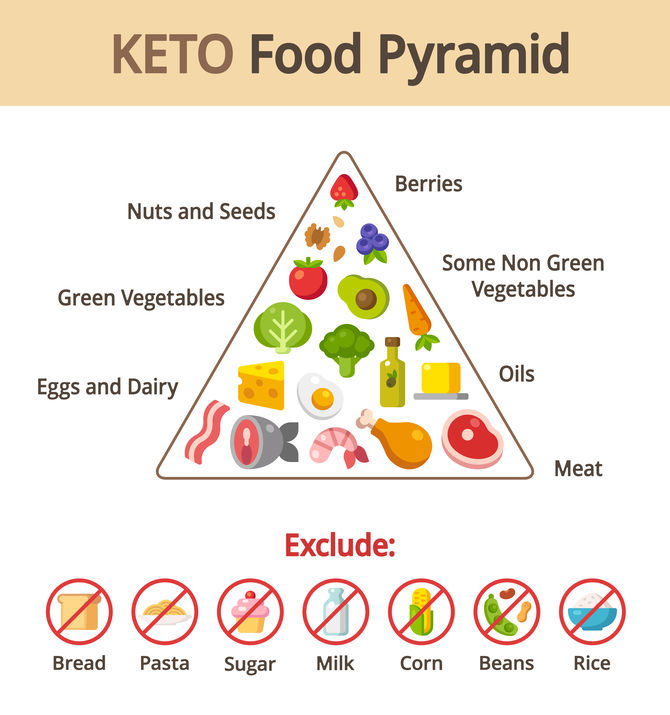
The one thing the traditional food pyramid did get right was the visual impact it made. It was an effective teaching tool that was easy to follow, and since many people struggle with what they need to eat in order to stay in ketosis, it only made sense to use the same visual element with a few major adjustments. Thus the keto diet pyramid was born.
Instead of 6 horizontal blocks, the keto pyramid includes 7 different blocks to accommodate each food group recommended on the diet with the typical daily ratios being 5-10% of carbs, 15-25% proteins, and 70% dietary fats. The food groups displayed on the pyramid are:
- Meats
- Dairy and eggs
- Healthy oils
- Green vegetables
- Non-green vegetables
- Nuts and seeds
- Berries
These food groups are divided into three tiers to represent fats, which form the largest tier, followed by protein, and the smallest being carbs. As you can see from the visual representation, there are a few foods that have been excluded from the eating plan due to their high carb and glycemic content which include the following:
- Breads
- Grains
- Cereal
- Beans
- Potatoes
- Corn
- Milk
- Sugar
- Alcohol
The seamless design of the pyramid combined with a good quality keto supplement like Approved Science Keto can help you reach your weight loss and health goals with ease. Once you have a clear idea of your macros and what foods you should be eating, half the work has already been done.
How The Keto Diet Food Pyramid Addresses The Current Flaws
The main goal of the keto diet and keto food pyramid is to switch your body’s primary source of energy to a more efficient fuel source. By default, our bodies are set to burn glucose (carbs) for fuel, which is one of the main reasons why the traditional food pyramids suggest eating more calories from carbs. The keto diet takes a different approach. Instead of using glucose, our bodies revert to burning healthy fat (ketones) for fuel when a state of ketosis is induced.
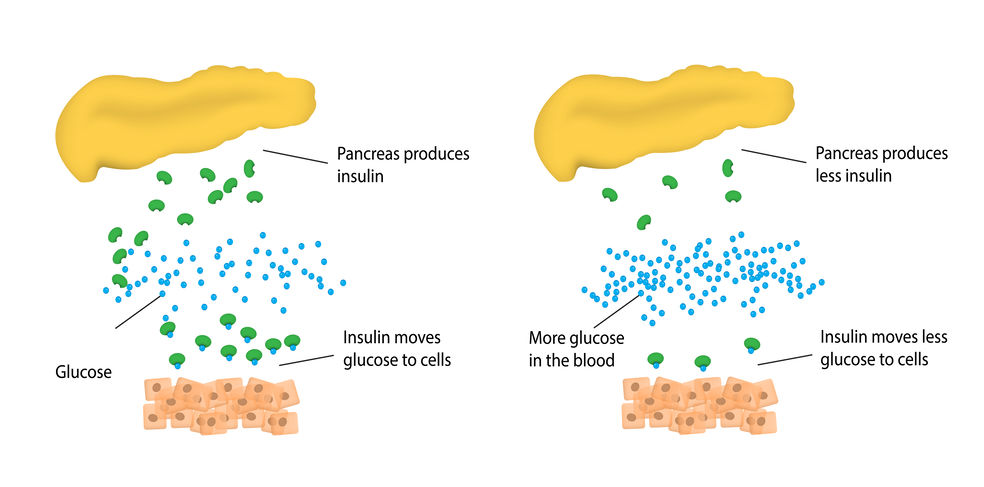
While glucose may be the general factory setting for our bodies, it doesn’t necessarily mean it’s the best or most efficient source of fuel. The reason our bodies choose glucose over any other chemical is that glucose can be broken down into energy much faster. But this comes with its own set of problems. In order to balance the spike in blood sugars caused by glucose, the pancreas must secrete insulin, however, for some, the pancreas does not secrete enough insulin to offset the glucose. When this happens, blood sugar skyrockets and behaves almost like a slow-acting poison, which causes damage to the cells and leads to some serious health conditions. Besides skyrocketing blood glucose, the process of breaking down glucose and secreting insulin also causes harmful oxygen species to be released in the body.
Fats or ketones, on the other hand, are a more efficient and sustainable way of sourcing fuel for the body. Vital organs such as the heart and brain rely on fatty acids for energy, which is why opting for a low-fat diet may not be in your best interest. Various studies have also shown that ketosis does not cause much oxidative harm when compared to glucose. In fact, some research suggests that burning fats for fuel inhibit free radical damage by increasing glutathione levels, which is a powerful antioxidant found in the mitochondria.
While the body still needs glucose to fuel cells and the liver with energy, it does not need to be sourced from carbohydrates. The body has a clever way of breaking down proteins into glucose via a complex process known as gluconeogenesis. From a biological standpoint and based on evidence, there is no reason why carbohydrates should make up the biggest portion of every meal.
It may seem a bit counterintuitive to eat fats to burn fats but studies have proven time and time again that even though fats do have a higher calorie count per gram, healthy foods that are naturally high in fat lead to a reduction in appetite because they keep you feeling fuller for longer and are difficult to overeat.
How To Eat According To The Keto Food Pyramid
Reaching ketosis is by no means an easy feat especially when everything you have been taught about nutrition gets turned over, but it is possible. The diet is about choosing high-quality calories over ones that are empty or highly processed. It’s about opting for the avocado instead of grapes because of the sugar content or insisting on a bunless slider without the added sauces. The keto diet pyramid helps to make you more aware of what you are putting in your body so that you can reap all of the health and weight loss benefits the diet has to offer.
Boost Your Fat Intake
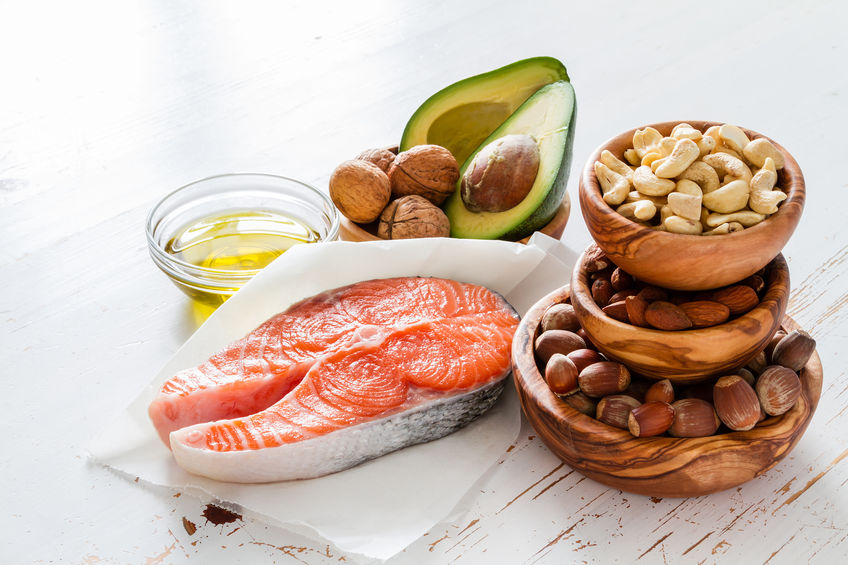
On the keto diet, fats should make up about 70% of your daily meals. Now that we have learned that fats are an efficient source of energy for your heart, brain, and other vital organs, it is also important to note that like most foods, no fats are created the same. Some fats should be avoided altogether and others that should form part of your daily diet. The fats found in processed foods like trans fats should be avoided because of their health risks. Trans fats increase your chances of developing heart disease, diabetes, and stroke. The healthy fats you do want to incorporate into your diets are the polyunsaturated and monounsaturated versions with some saturated fat in moderation.
A few healthy fats that fit into the keto diet pyramid are:
- Fatty fish such as salmon, tuna, and mackerel
- Fish and krill oil
- Flaxseeds
- Chia seeds
- Pumpkin seeds
- Sesame oil
- Flaxseed oil
- Avocado oil
- MCT oil
- Olive oil
- Nuts
- Grass-fed meat
- Grass-fed butter or ghee
Boosting your fat intake will help keep you feeling fuller for longer and rev up ketone production so that you can maintain a healthy state of ketosis and start melting away the pounds. If you have trouble reaching ketosis at first, try to speed up results with a high-quality keto supplement like Approved Science Keto. These exogenous ketones will give you the energy boost you need, regulates blood sugar levels, and keeps your electrolytes in check, which helps to stave off keto flu symptoms.
Eat A Moderate Amount Of Protein
Most weight-loss diets that have been cropping up in recent years encourage dieters to eat high amounts of protein every day. With the keto diet, the rules are a little bit different. Proteins should only make up 25% of your daily calories. If you want to reach a state of ketosis, it is important to eat protein in moderation because of the unique process we discussed earlier – gluconeogenesis. Gluconeogenesis is crucial on the keto diet because some cells and organs are dependant on glucose in order to function, but when there is an excess of glucose from high amounts of protein, the body will revert back to burning glucose as its primary source of energy, which means that you won’t reach ketosis. Some of the fatty foods we listed above are great sources of protein so it is important to keep that in mind when calculating your macros.
Here are a few protein-rich food options on the keto food pyramid:

- Full-fat dairy products like cheese and cream
- Eggs
- Shrimps
- Oysters
- Lobster
- Muscles
- Chicken
- Cold cuts
- Bacon
- Scallops
- Lean meat
- Fatty meat
You may notice that whole milk has been excluded from the list. The reason is that whole milk, while it may be healthy, still contains a lot of carbs due to its lactose content. One glass of whole milk is equivalent to a whopping 11 grams of carbs. Low-fat dairy is also not an option. Don’t let the “low fat” label fool you, it still contains a lot of carbs, which can send your ketone levels plummeting.
Choose Healthier Treats
We are only human, and all humans deserve a tasty treat. Instead of reaching for candy bars and baked desserts, the keto food pyramid encourages users to opt for healthier snacks and treats. These include nuts, a few fruits, and berries. Nuts are a wonderful source of fat and have been shown to benefit our health in many ways. Berries are low in sugar and filled with potent antioxidants that protect our cells against free radical damage. Since these treats are deliciously tasty, portion control is key to stay in ketosis.
Some keto-friendly options include:

- Walnuts
- Macadamia
- Pecans
- Almonds
- Peanuts
- Raspberries
- Blackberries
- Strawberries
- Cantaloupe
- Watermelon
Choose Carbs Wisely
This is the hardest part of the keto diet. We have grown so accustomed to eating breads, pastas, and rice, which is not so easy to boot out at first. The diet only allows for your meals to be made up of 5% carbs which is not a lot considering most foods on this planet contain carbs, but it is possible. You just have to be smart about the carbs you choose to eat. Instead of eating a bowl of cereal or serving your steak with a side of rice, opt for low carb veggies, nuts, and seeds. If you are wondering what vegetables are low in carbs, a good rule of thumb is to look at where it grows. potatoes, which are grown below ground have a much higher carb count than a vegetable that is grown above ground like mushrooms, broccoli or zucchini.
Here are a few great low-carb options according to the keto food pyramid:

- Cauliflower
- Broccoli
- Asparagus
- Brussels sprouts
- Zucchini
- Spinach
- Peppers
- Kale
- Cabbage
- Avocado
- Olives
- Swiss chard
- Cucumber
- Celery
Breaking Down The Keto food Pyramid
With so many health epidemics on the rise, it only made sense for health organizations to encourage consumers to change their eating habits. Unfortunately, some of the science failed to address the issues. The stigma that fats are unhealthy and carbohydrates are a better choice are slowly being debunked with new research on a daily basis. Scientists are quickly realizing that low-carb high-fat diets are benefiting individuals who are obese, diabetic, and epileptic in more ways than the traditional low-fat high-carb diets.
Fortunately, there is a new food pyramid on the block that not only addresses these health epidemics but also helps our bodies to become adapted to a more efficient fuel source – fats. The keto food pyramid is just as easy to use and helps us to become more aware of what we put into our bodies. It’s simple, eat a substantial amount of healthy fats, include a moderate amount of protein, limit carbs, and treat yourself with healthier options like nuts and berries. With these simple guidelines and a good quality keto supplement, your body will be reaping the benefits in no time.

